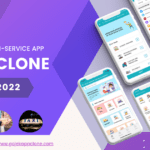In this fast-paced environment, users demand more effective solutions for their financial activities. Thus, FinTech apps are gaining more popularity. You can find various apps to execute financial services, whether for money transfers, loans, bill payments, invoices, or financial advice.
As per Statista, financial technology sector revenue is expected to reach more than $205 billion by 2024.

So, how can you develop the best Fintech app that fulfills your users’ needs and provide them a seaming experience? This blog will explain the top mobile banking trends and how you can integrate them into your FinTech apps.
Top 7 Trends in Mobile Banking
- Blockchain
- Gamification
- Nudge theory
- Voice processing
- Biometrics
- Social integration
- Personalization
How to Design FinTech App Using These Trends
For a FinTech app to be effective, you must provide the perfect banking user experience with a simple and intuitive design. Therefore, cutting-edge technology and trends are needed to be implemented.
Here’s how you can use the top 7 mobile banking advanced trends to design FinTech apps.
1. Blockchain Solutions for Optimized Services
Blockchain technology is one of the popular trends in FinTech apps. Its application can transform financial services entirely with transparent, secure, and convenient transactions. The use of the blockchain network can also improve the speed of the transaction.
One of the prominent advantages of Blockchain technology in banking procedures is automation. In this fast-paced environment, no one has the time to wait in a queue and fill out lengthy forms. In this case, Blockchain is particularly well suited as it can trace the ownership of assets and make authentication and accessing the record effortlessly.
2. Gamification of FinTech Apps
Technological advancement has made financial services more interactive and captivating. Rewards points and graphical representation of the financial reports can be used to gamify the banking user experience. It would be best if you entertain your users to make them come to your app again.
You can provide rewards for attaining savings and investment goals, participating in community activities, acquiring a new banking service, and more. The points earned by the users can ensure service discounts or exclusive offers, gifts, and free goods.
Also, social media sharing can be an excellent tool for cross-promotions.
3. Real-Time Analytics Based on Nudge Theory
The FinTech app can leverage real-time analytics and the nudge theory to assist customers in managing their finances efficiently. FinTech apps involve checking account balance, transaction history, and authentication. Therefore, you need more than a simple view of account transactions.
You can integrate the activity feed similar to the Facebook or Twitter timeline to view the transaction history. Thus, your users can access the transactions, remaining account balances, and notifications using a single timeline, making it more transparent for mobile users.
Users can also view tips and advice on banking services using predictive analytics as per nudge theory.
4. Voice-Assistance for Improved User Experience
As the competition increases in the app development industry, your app must offer unique features with better app performance. Therefore, your FinTech app should be a personalized financial assistant and adequately address user queries.
AI-based voice processing in FinTech apps provides instant assistance to the users. Combining big data and AI capabilities transforms the financial industry with precise results.
5. Ensure a Robust User-Authentication System
Since FinTech apps store your sensitive data, providing a secure platform with user authentication becomes essential. You may access your account for various purposes, such as bill payments, money transactions, and checking account balances. Therefore, user authentication will ensure only you have the right to access your account information.
Nowadays, FinTech development companies use biometrics methods to verify user identity. It may include TouchID, FaceID, or VoiceID with security settings. It can assure instant and secure access to the user dashboard.
6. Personalization of Ads and Information
You can provide personalized promotions using artificial intelligence. In FinTech apps, using AI, you can take the essential and valuable services into account and offer the correct information to the user at the right time.
Personalization of advertisement can be done by predictive analytics, data analysis, geolocation data analysis, user’s behavioral pattern analysis, etc. For example, location-based push notifications or a loan offer.
Your FinTech ads must provide everything needed with just a few clicks, which can significantly increase user engagement.
7. Social Media Integration for Information Exchange
You can integrate social media or enable smart contact synchronization into your FinTech apps to allow faster money transfers or requests to friends. You can also include the section in the activity feed to ask for opinions, advice, and tips on different financial services.
Predictive analytics, data analysis, and information on social networks will help generate personalized proposals. Hence, it will increase user engagement with your Fintech apps.
Conclusion
You can turn your app idea into reality using the latest trends and technology. With the right set of app features, you can provide a robust user experience through your app, resulting in market success and long-term customer loyalty.
Hope this blog helps you design your FinTech app and choose the relevant features.
Author’s Bio
Tom Hardy is a Sr. Software Developer in a FinTech development company. Also, he is a passionate blogger and loves to write blogs in his free time to share his knowledge and solve user queries related to the financial industry.








